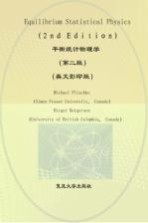

平衡统计物理学 第2版 英文影印版PDF电子书下载
- 电子书积分:16 积分如何计算积分?
- 作 者:(加)普里斯科著
- 出 版 社:上海:复旦大学出版社
- 出版年份:2006
- ISBN:7309052005
- 页数:520 页
1 Review of Thermodynamics 1
1.1 State Variables and Equations of State 2
1.2 Laws of Thermodynamics 3
1.2.1 First law 4
1.2.2 Second law 5
1.3 Thermodynamic Potentials 10
1.4 Gibbs-Duhem and Maxwell Relations 13
1.5 Response Functions 15
1.6 Conditions for Equilibrium and Stability 17
1.7 Thermodynamics of Phase Transitions 19
1.8 Problems 23
2 Statistical Ensembles 29
2.1 Isolated Systems:MicrocanonicalEnsemble 30
2.2 Systems at Fixed Temperature:Canonical Ensemble 35
2.3 Grand Canonical Ensemble 40
2.4 Quantum Statistics 43
2.4.1 Harmonic oscillator 44
2.4.2 Noninteracting fermions 44
2.4.3 Noninteracting bosons 45
2.4.4 Density matrix 46
2.5 Maximum Entropy Principle 48
2.6 Thermodynamic Variational Principles 51
2.7 Problems 53
3 Mean Field and Landau Theory 61
3.1 Mean Field Theory of the Ising Model 63
3.2 Bragg-Williams Approximation 65
3.3 Order Disorder Transition 69
3.4 Bethe Approximation 74
3.5 Critical Behavior of Mean Field Theories 77
3.6 Ising Chain:Exact Solution 80
3.7 Landau Theory of Phase Transitions 86
3.8 Example of Symmetry Considerations:Maier-Saupe Model 89
3.9 Landau Theory of Tricritical Points 96
3.10 Landau-Ginzburg Theory for Fluctuations 103
3.11 Multicomponent Order Parameters:n-Vector Model 107
3.12 Mean Field Theory of Fluids:Van der Waals Approach 109
3.13 Problems 115
4 Dense Gases and Liquids 123
4.1 Virial Expansion 125
4.2 Distribution Functions 131
4.2.1 Pair correlation function 131
4.2.2 BBGKY hierarchy 137
4.2.3 Ornstein-Zernike equation 138
4.3 Perturbation Theory 141
4.4 Inhomogeneous Liquids 143
4.4.1 Liquid-vapor interface 143
4.4.2 Capillary waves 149
4.5 Density-Functional Theory 151
4.5.1 Functional differentiation 151
4.5.2 Free-energy functionals and correlation functions 153
4.5.3 Applications 159
4.6 Problems 161
5 Critical Phenomena Ⅰ 163
5.1 Ising Model in Two Dimensions 164
5.1.1 Transfer matrix 164
5.1.2 Transformation to an interacting fermion problem 168
5.1.3 Calculation of eigenvalues 171
5.1.4 Thermodynamic functions 174
5.1.5 Concluding remarks 179
5.2 Series Expansions 179
5.2.1 High-temperature expansions 180
5.2.2 Low-temperature expansions 186
5.2.3 Analysis of series 186
5.3 Scaling 191
5.3.1 Thermodynamic considerations 191
5.3.2 Scaling hypothesis 192
5.3.3 Kadanoff block spins 195
5.4 Finite-Size Scaling 199
5.5 Universality 204
5.6 Kosterlitz-Thouless Transition 206
5.7 Problems 214
6 Critical Phenomena Ⅱ:The Renormalization Group 217
6.1 The Ising Chain Revisited 218
6.2 Fixed Points 222
6.3 Position Space Renormalization:Cumulant Method 228
6.3.1 First-order approximation 232
6.3.2 Second-order approximation 234
6.4 Other Position Space RenormalizationGroup Methods 237
6.4.1 Finite lattice methods 237
6.4.2 Adsorbed monolayers:Ising antiferromagnet 238
6.4.3 Monte Carlo renormalization 243
6.5 Phenomenological Renormalization Group 246
6.6 The ε-Expansion 249
6.6.1 The Gaussian model 251
6.6.2 The S4 model 255
6.6.3 Critical exponents to order ε 258
6.6.4 Conclusion 264
6.7 Problems 265
7 Simulations 271
7.1 Molecular Dynamics 272
7.2 Monte Carlo Method 277
7.2.1 Markov processes 277
7.2.2 Detailed balance and the Metropolis algorithm 279
7.2.3 Histogram methods 282
7.3 Data Analysis 284
7.3.1 Fluctuations 284
7.3.2 Error estimates 286
7.3.3 Extrapolation to the thermodynamic limit 287
7.4 The Hopfield Model of Neural Nets 290
7.5 Simulated Quenching and Annealing 295
7.6 Problems 298
8 Polymers and Membranes 301
8.1 Linear Polymers 302
8.1.1 The freely jointed chain 304
8.1.2 The Gaussian chain 307
8.2 Excluded Volume Effects:Flory Theory 309
8.3 Polymers and the n-Vector Model 313
8.4 Dense Polymer Solutions 317
8.5 Membranes 323
8.5.1 Phantom membranes 324
8.5.2 Self-avoiding membranes 327
8.5.3 Liquid membranes 332
8.6 Problems 336
9 Quantum Fluids 339
9.1 Bose Condensation 339
9.2 Superfluidity 347
9.2.1 Qualitative features of superfluidity 347
9.2.2 Bogoliubov theory of the 4He excitation spectrum 356
9.3 Superconductivity 359
9.3.1 Cooper problem 360
9.3.2 BCS ground state 361
9.3.3 Finite-temperature BCS theory 365
9.3.4 Landau-Ginzburg theory of superconductivity 369
9.4 Problems 373
10 Linear Response Theory 377
10.1 Exact Results 378
10.1.1 Generalized susceptibility and the structure factor 378
10.1.2 Thermodynamic properties 385
10.1.3 Sum rules and inequalities 386
10.2 Mean Field Response 388
10.2.1 Dielectric function of the electron gas 389
10.2.2 Weakly interacting Bose gas 391
10.2.3 Excitations of the Heisenberg ferromagnet 393
10.2.4 Screening and plasmons 396
10.2.5 Exchange and correlation energy 402
10.2.6 Phonons in metals 404
10.3 Entropy Production,the Kubo Formula,and the Onsager Rela-tions for Transport Coefficients 406
10.3.1 Kubo formula 406
10.3.2 Entropy production and generalized currents and forces 408
10.3.3 Microscopic reversibility:Onsager relations 410
10.4 The Boltzmann Equation 414
10.4.1 Fields,drift and collisions 414
10.4.2 DC conductivity of a metal 417
10.4.3 Thermal conductivity and thermoelectric effects 419
10.5 Problems 423
11 Disordered Systems 429
11.1 Single-Particle States in Disordered Systems 431
11.1.1 Electron states in one dimension 432
11.1.2 Transfer matrix 433
11.1.3 Localization in three dimensions 439
11.1.4 Density of states 441
11.2 Percolation 446
11.2.1 Scaling theory of percolation 448
11.2.2 Series expansions and renormalization group 451
11.2.3 Conclusion 453
11.3 Phase Transitions in Disordered Materials 454
11.3.1 Statistical formalism and the replica trick 455
11.3.2 Nature of phase transitions 458
11.4 Strongly Disordered Systems 463
11.4.1 Molecular glasses 463
11.4.2 Spin glasses 465
11.4.3 Sherrington-Kirkpatrick model 470
11.5 Problems 476
Appendix:Occupation Number Representation 481
Bibliography 495
Index 511
- 《建筑施工企业统计》杨淑芝主编 2008
- 《新编高中物理竞赛教程习题全解》钟小平主编;钟小平,倪国富,曹海奇编写 2019
- 《数学物理方法与仿真 第3版》杨华军 2020
- 《中学物理奥赛辅导:热学 光学 近代物理学》崔宏滨 2012
- 《长江口物理、化学与生态环境调查图集》于非 2019
- 《大学物理简明教程 下 第2版》施卫主编 2020
- 《慢性呼吸系统疾病物理治疗工作手册》(荷)瑞克·考斯林克(RikGosselink) 2020
- 《医学物理学》洪洋 2020
- 《初中物理知识地图》赵端旭 2017
- 《教师教育系列教材 心理学原理与应用 第2版 视频版》郑红,倪嘉波,刘亨荣编;陈冬梅责编 2020
- 《中风偏瘫 脑萎缩 痴呆 最新治疗原则与方法》孙作东著 2004
- 《水面舰艇编队作战运筹分析》谭安胜著 2009
- 《王蒙文集 新版 35 评点《红楼梦》 上》王蒙著 2020
- 《TED说话的力量 世界优秀演讲者的口才秘诀》(坦桑)阿卡什·P.卡里亚著 2019
- 《燕堂夜话》蒋忠和著 2019
- 《经久》静水边著 2019
- 《魔法销售台词》(美)埃尔默·惠勒著 2019
- 《微表情密码》(波)卡西亚·韦佐夫斯基,(波)帕特里克·韦佐夫斯基著 2019
- 《看书琐记与作文秘诀》鲁迅著 2019
- 《酒国》莫言著 2019
